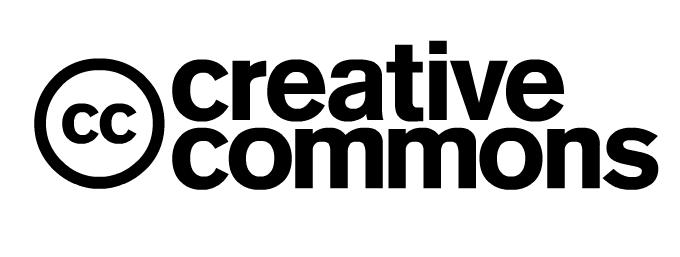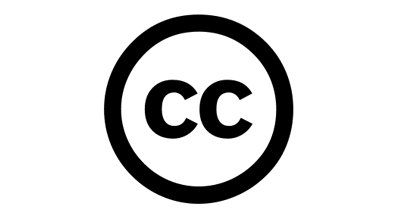
The Creative Commons licenses
The legislation on subject matter of copyright (at least in theory) establishes very restrictive regulations on its use (Copyright or “All rights reserved“). But, it can often be profitable for the author to share his work with users so that it can be spread as much as possible. In order to facilitate the distribution of the work is therefore necessary to reduce these restrictions (hence the term “license” means “permission”, “consensus”, pay attention to this, the licenses do not protect, actually, they do the opposite).
Now the complete absence of any restrictive formula, including the authorship of the work, defines a work in the Public Domain. This mode is rarely desired by the author. The Creative Commons licenses go to create different levels of intermediate licenses between a work in Copyright and in Public Domain.
In this regard, the Creative Commons licenses are a standard way to give the public permission to use and share creative work under the conditions laid down by the creators.
Creative Commons licenses are originally born in the U.S. according to their local legal system. It was subsequently adapted to the different legal systems of other nations, including the Italian, where the copyright is governed by the law 633/41 (art. 6) (for details see here).
The Creative Commons licenses are based on a set of 4 options that describe some author’s exclusive rights (clauses).
The 4 clauses of CC licenses
Attribution (BY)
You should always indicate the author of the work (mandatory attribute) so that it is possible to attribute the authorship.
.
Non-commercial use (NC)
The commercial use of the work is not permitted.
.
No derivative works (ND)
You can copy, distribute, display and perform only verbatim copies of the work, not derivative works based on it.
.
Share-Alike (SA)
You may distribute derivative works only under a license identical to the license that governs the original work.
.
Depending on which exclusive rights (clauses) are retained by the author of the work, a different Creative Commons license is defined. These licenses go to lay in a gradual interval between the Copyright and the Public Domain.
Types of Licenses
The Creative Commons licenses (CC) that arise from the combination of the various clauses, as described before, are 6.
- BY : Attribution
- BY-ND : Attribution – No derivative works
- BY-NC : Attribution – Non-commercial
- BY-SA : Attribution – Share-alike
- BY-NC-ND : Attribution – No derivative works – Non-commercial
- BY-NC-SA :Attribution – Non-commercial – Share-alike
In the following figure you can see how the scale of rights 6 CC licenses could be defined in the range between Copyright and Public Domain.
A “three-layer” license
The way how these licenses are assigned to the various works is very innovative. The Creative Commons organization provides us with standard RDF/XML metadata to be attached to the work published online. These metadata define the type of license assigned, as well as making their automatic recognition easier. Indeed, the presence of such metadata facilitates the automatic spreading of the work by specific tools that promote works under CC license in Internet.
CC licenses are constituted by a three-layer structure. Each layer has a specific level of readability according to the function it has to perform, and to whom it is addressed.
- Legal Code
- Human Readable
- Machine Readable
Legal code: it is the first layer and is presented in textual form. Its content is expressed in a strictly legal language (the traditional legal license).
Human readable (Commons Deed): it is the intermediate layer. It is presented in visual form and quickly readable by users. This layer, if taken individually, does not represent any license.
Machine readable: it is the lowest level layer. It is expressed in form of metadata, that is, in a format that only software, search engines and other similar technologies can read and interpret (CC Rights Expression Language)
How to assign a CC license
Now that we have seen what the CC licenses are and what they do, now it is time to understand how you can assign them to your works.
The Creative Commons organization provides a useful tool to facilitate both the choice and the assignment of the CC license that best meets our needs. This tool is the CC license chooser.
This tool is represented by a web page where you have to answer a few questions by filling out the appropriate fields. At the end of the procedure, depending on the answers you have given, you will receive one of the six CC licenses in the form of a HTML formatted code. At this point, you will copy the HTML text directly into your web page where you show your work (considering even the same web page as a work).
A no less important and not to be overlooked thing is to write the descriptive text attached to the CC license so that it can fit as much as possible to your needs. In this regard, however, you should go to look for examples on the official website of Creative Commons or examples written by others before you.
This is a example:
“Except where otherwise noted, content on this site is licensed under a Creative Commons Attribution 3.0 License“.
as you can see, there is a hyperlink in correspondence with the words “Creative Commons ….”. If you click on it, you can load a web page that displays all the specifications of the license granted, in this case a CC-BY. The loaded page, as shown below, is the Human Readable layer(Commons Deeds) which we discussed previously.
Now your work is licensed as “open” and is ready for the free sharing, to be adapted and reused, but retaining the authorship of the content. This is the meaning of OPEN. Unfortunately, with regard to the protection of what you have done, it will not be the CC license to protect your work (in fact, a license will facilitate the free distribution, so you are going in the opposite direction). Actually, your authorship should be protected when your work is just created (so at least in theory), but unfortunately, in most cases, it is the integrity of those who will use your work to establish this.
Some things to consider before you assign a CC license
Be careful, think carefully before you assign one of the 6 licenses. There are some important considerations to make before.
First, always keep in mind that once you assigned a CC license to your work, this can not be revoked. Only a still less restrictive license can be applied to your work, getting closer and closer to the Public Domain. In fact, once you’ve applied a specific CC license for your own work, it is available online and consequently it is distributed in accordance with the restrictions set in the CC license. Once this material is in the possession of third parties, these will use it according to the instructions given at the time of the acquisition, even if later you decided to stop distribution of that work.
Always make sure if the material, to which you are assigning a CC license, is appropriate to submit to such license. Indeed, there are some subtle situations where such a choice may not be appropriate or what ever useless. For example, the CC licenses are not suitable if you have developed a software since the CC license, as it is structured, does not take into account source code or other components as part of the work, and thus not specifying their treatment. For such types of works it is advisable to apply other classes of licenses, such as those made available by another organizations, for example the Free Software Foundation.
Register you work in the Content Directories
After you assign a CC license to your work, the next step would be to upload it into public repositories which share similar material under CC license. These services are called Content Directories (here you can find a list of these services, categorized according to their type such as video, images, audio, etc,)
Perhaps the most famous of these services is Flickr.com, a site dedicated to the distribution of photographic material. This site allows anyone to share their photographic works. It belongs to the Yahoo group and requires an account if you want to access (something extremely boring, since it requires the mandatory insertion of the mobile phone number to which it sends a verification code with which you can access).
This Web service provides you with a 1TB of space on which you can upload your own pictures, and also thanks to various search tool, you can see millions of pictures (professionals and less) shared by other users.
Conclusions
This article has not the intension to discourage an author to make use of Creative Commons licenses for his work. Indeed, far from it. It’s just important you first have a clear idea of the instrument (in this case a license) that you are using, what is it, what are its limits, and if it is the most suitable for your needs. In fact, it is not uncommon to find people complaining in blogs for Creative Commons licenses. This is not attributable to the licenses, but also to various misconceptions and the fact that the copyright is not respected as full Copyright, let alone as Creative Commons.
